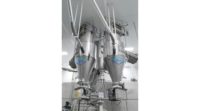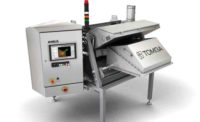Streamlining snack and bakery operations through automated ingredient handling

courtesy of Bühler Aeroglide

courtesy of Key Technology

courtesy of Key Technology

courtesy of Brabender Technologie

courtesy of Key Technology





Ingredient handling equipment, such as batchers, hoppers, pneumatic conveyors, sifters, sorters and storage silos, helps snack and bakery operations store, refine, prepare, measure and transport ingredients, streamlining production.
This equipment helps manufacturers automate production, saving time and money. It also enables the flexibility to efficiently handle different batch sizes, opening the opportunity to make snacks and baked goods that feature niche ingredients. New and updated ingredient handling equipment frequently feature designs that offer easy access for inspection and cleaning, and address food-safety issues safely handling allergens.
Meeting operational needs
Bühler Aeroglide, Cary, NC, sees customer requests related to food safety and managing allergens, as well as the ability to open and inspect equipment in a matter of minutes for greater overall efficiency, says John Hunter, sales account manager, bakery and ingredient handling. “Where we know we’re going to be using allergens, we have to have a solution that we can sanitize, whether wet or dry sanitation. That’s a key driver in a modern plant.”
Brabender Technologie, Duisburg, Germany, has been working with customers of all different sizes that want to automate in a way that’s cost-effective for them. The company attempts to provide “a way for the client, whether it’s a Fortune 500 or a small operation, to experience automation and decide from there the next steps,” says Grant Olmes, regional sales manager, Midwest and central U.S. He notes interest is increasing from customers who didn’t know they could get into automation so economically.
Customers of Key Technology, Walla Walla, WA, have been concerned about food safety and cleanability, says John Kadinger, market manager. “They’re looking at moving foreign materials—glass, metal, anything that could cause injury,” he says. “They want something that’s easy to maintain and easy to clean. They want to be able to change from one new product to another quickly—quick cleanup and quick washdowns.”
Darren Adams, vice president of engineering, The Fred D. Pfening Co., Columbus, OH, cites accuracy and batch control as among his customers’ top concerns. “We see smaller, gluten-free, non-GMO batch operations occurring in larger facilities,” he says. “The advancement of control systems gives people at the facilities the power to create their own system based on their needs—a gluten-free batch can be programmed on the same equipment as all-organic or standard bread. You can run a batch for a tortilla, a loaf of bread, or snack crackers off the same system.”
New and improved
Flexibility of ingredient mixing has been a key aspect of the DymoMix system from Zeppelin Systems USA, Odessa, FL, according to Nathan Davis, applications engineer. The unit meters blended dry ingredients, which fall through it as liquid ingredients are injected, creates a hydrated, homogenous blend to be deposited into a batch or continuous mixer.
“Bakeries benefit from the flexibility of the DymoMix, as it is capable of mixing flour and water together at various concentrations for different product needs,” says Davis. “This pre-hydration cuts down on the final mixing time and reduces the dust associated with flour handling. Also, the hydration can be changed for various products—sometimes they want a heavier water-to-flour mixture, which allows you to make pretzels, cookies and breads.”
The WinCos plant control system from Bühler Aeroglide provides ingredient precision through recipe control features, notes Hunter. “We have controls that reduce the risk of people sending the wrong ingredient to the wrong place,” he says. “If it goes to the wrong bin, it won’t allow you to start.” The system helps to separate allergens and non-allergens, he adds. The company’s hydration systems and liquid dough systems are designed so they can be opened and inspected in 30 seconds. “The mixer design is all about how we get in and how we can get control,” he says. “Being able to inspect it so quickly—that’s a big change in the design.”
Brabender Technologie can offer a low-cost FlexWall/DSR/DVT-Gravimetric Batching System for automatic batching of multiple micro-ingredients, or provide larger systems that handle many more ingredients, says Yves Forde, regional sales manager, West Coast and Great Lakes. “I am sometimes dealing with smaller organizations that are trying to compete with much larger groups. Hand batching and manual material transfer is common, and a lot of manual energy is required as a result. For a group working together to put out specialty products, there is an intimidation factor with technology. Our microsystems are literally a micro-footprint, complete with a color/graphic operator interface that’s easy to use.”
Small operators appreciate the ability to automate to save time, Forde says. “You know your bag is going to be accurate, so you can figure out another part of your business. You can call it a time-saver in that sense.”
The VERYX C70 Digital Sorter from Key Technology is a new version of the company’s chute-fed sorting system that’s ideal for larger particulates like dried fruit, nuts and cocoa beans, which can be variously either dehydrated, dried, fresh or frozen, Kadinger says. “Berries are a good example,” he says. “For a snack product, you would want them dehydrated, but for a baking application, perhaps fresh or frozen.”
Key Technology also has introduced enhancements to its vibratory conveyors, including the Iso-Flo, Impulse, Horizon and Marathon lines for food processing and packaging, that have improved sanitation and cleanability, notes Kadinger says. “Traditionally, on most equipment, there are safety labels that feature some sort of adhesive stuck to the metal. We’ve gone away from that and put them on the standoff, which reduces places for bacteria to harbor.”
The Fred D. Pfening Co. has introduced a number of new or improved ingredient handling systems, Adams says. Among those are the Enviro-Blender, an automatic temperature blender and metering system that saves time, energy and money by wasting zero water in achieving the desired temperature, which it does by modulating the blending valve throughout the draw.
Pfening also has introduced the Model 10 S/S Feeder, a stainless steel, blow-through rotary airlock feeder that’s typically mounted under a bin while steadily feeding bulk material into a pneumatic conveying line. And the company offers the companion fully enclosed, stainless steel Bag Dump Station for loading smaller portions of ingredients from bags or containers, discharged into a pneumatic conveying line by the Model 10 S/S.
Introducing more automated batching opens new opportunities. “It’s giving you the ability to not have to spend what you would on true minor ingredients and getting them to closer bulk price,” says Adams. This improves margins and opens the door to offering a wider variety of finished products—all of which improves the bottom line.
Looking for a reprint of this article?
From high-res PDFs to custom plaques, order your copy today!










